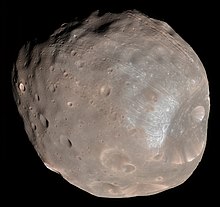User:Kaustubhhirve/sandbox
Martian Moon Exploration
[edit]The mission will travel to Mars and survey the red planet’s two moons; Phobos and Deimos. The spacecraft will explore both moons and collect a sample from one of the moons to bring back to Earth.[1]ISAS/JAXA plan to launch the orbiter in early 2020s. In order to retrieve the samples, the spacecraft will need to complete a roundtrip to Mars, circle around the moon and land on its surface. The most complex and risky parts of this mission are the operations around the moons and the descent and landing. These heavily constrain the system design and have involved an in-depth study from the earliest stages of the mission.[2]

The primary mission objective is to distinguish between the two leading hypotheses for the origin of Phobos and Deimos. The first of thesesuggests the moons are captured primitive asteroids, while the second proposes that they are the agglomerated fragments of a giant impact event on Mars. The second objective is to characterise the conditions on and around the moons. This includes surface processes on Phobos and Deimos, the nature of the circum-Martian environment (the region where objects orbit around the planet) and the global and temporal dynamics of Mars’s atmosphere, such as dust, ice, clouds and water vapour.[4]

Mission Objectives
[edit]Mars is the outermost rocky planet in our Solar System and marks the boundary between terrestrial planets with solid surfaces and thin atmospheres, and the gas giants worlds like Jupiter and Saturn.
Understanding the origin of our fourth planet’s moons will give clues to how the planets formed around our Sun and in turn, around other stars. If captured, these small satellites are evidence of the material that was scattered inwards towards the Sun by the gas giant planets. This would make them kin to the meteorites that struck the early Earth and possibly delivered water and organic compounds to our planet. Alternatively, Phobos and Deimos may be the remnants of a giant collision with Mars that threw material from the Martian surface to accumulate into the two moons. In this case, the moons may be a time capsule for early Martian conditions and reveal details on the giant impact process that is also thought to have formed our own Moon.
The goal of the mission is to reveal the origin of the Martian moons and progress our understanding of planetary system formation and primordial material transport around the boundary between the inner- and outer- early Solar System.

Preliminary Mission Schedule
[edit]
Main points are discussed below:
- Launch: September 2024
- Mars Arrival: August 2025
- Mars Departure: August 2028
- Return to Earth: July 2029
Probe
[edit]- Nominal science payloads
- Neutron and Gamma-ray Spectrometer (NGRS)
- Wide Angle Multiband Camera (WAM)
- Near-Infrared Spectrometer (NIRS)
- Telescopic Camera (TL)
- Light Detection and Ranging (LIDAR)
- Circum-Martian Dust Monitor (CMDM)
- Mass Spectrum Analyzer (MSA)
References
[edit]- ^ "MMX - Martian Moons eXploration". MMX - Martian Moons eXploration. Retrieved 2017-09-20.
- ^ "MMX - Martian Moons eXploration". MMX - Martian Moons eXploration. Retrieved 2017-09-20.
- ^ "Mars Orbiter Mission, ISRO Science Data Archives". MMX - Martian Moons eXploration. Retrieved 2017-09-20.
- ^ "MMX - Martian Moons eXploration". MMX - Martian Moons eXploration. Retrieved 2017-09-20.
